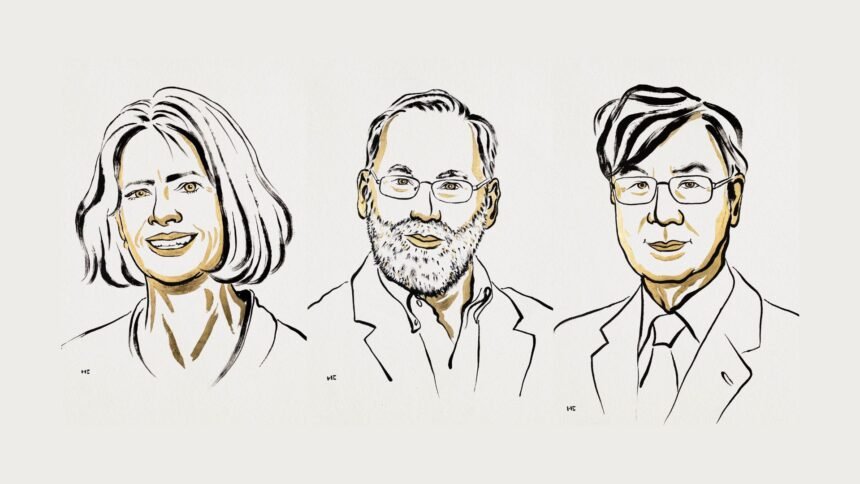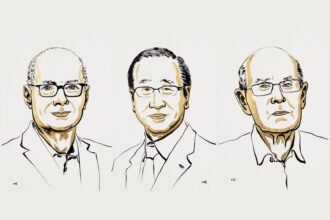New Delhi: The Nobel Assembly at Karolinska Institutet has awarded the 2025 Nobel Prize in Physiology or Medicine jointly to Mary E. Brunkow, Fred Ramsdell and Shimon Sakaguchi for their revolutionary “discoveries concerning peripheral immune tolerance”. Their combined work identified a specialized class of immune cells, called Regulatory T cells (Tregs) and the master gene that controls them, Foxp3, fundamentally changing our understanding of how the immune system is kept in check to prevent it from attacking the body’s own tissues.
This groundbreaking research has solved a long-standing puzzle in immunology and has paved the way for innovative therapeutic strategies for cancer, autoimmune diseases, and organ transplantation.
The Immune System’s Critical Balancing Act
The human immune system is a formidable defense force, tasked with identifying and eliminating a vast array of pathogens. A key feature is its ability to distinguish between foreign invaders and the body’s own cells—a phenomenon known as immune tolerance. For decades, the prevailing theory was that this tolerance was primarily established through a process called central tolerance.
Central Tolerance: This is a rigorous “training” process within the thymus gland where developing immune cells, known as T cells, are tested. Any T cells that show a strong reaction to the body’s own proteins are destroyed to prevent them from causing harm.
However, this system is not foolproof. Some self-reactive T cells inevitably escape this screening process and enter circulation. This begged the question: what prevents these rogue cells from launching an attack on our own organs, a condition the pioneering immunologist Paul Ehrlich termed “horror autotoxicus”? The work of this year’s laureates provided the definitive answer by discovering a crucial second layer of security: peripheral immune tolerance.
The Laureates and Their Converging Paths of Discovery
This Nobel-winning insight was the culmination of two initially separate, yet ultimately interconnected, lines of research pursued with remarkable persistence and ingenuity.
Shimon Sakaguchi: The Pioneer of Regulatory T Cells
In the 1980s and 90s, the idea of “suppressor T cells” that could calm the immune system had fallen out of favor in the scientific community. Shimon Sakaguchi, however, remained convinced of their existence.
- Inspired by earlier experiments where newborn mice, after having their thymus removed, developed severe autoimmune diseases, he hypothesized that the thymus must produce a cell type responsible for active suppression.
- In a pivotal experiment, he showed that injecting mature T cells from healthy mice could protect these thymectomized mice from autoimmunity, proving that a protective cell population existed within the mature T cell pool.
- After more than a decade of meticulous work, Sakaguchi achieved a breakthrough in 1995. He successfully isolated and defined this new class of T cells, demonstrating that they were characterized by the presence of two surface proteins: CD4 and CD25. He named them Regulatory T cells (Tregs), proving they were essential for maintaining self-tolerance.
Mary Brunkow & Fred Ramsdell: The Genetic Detectives
While Sakaguchi was identifying the cellular player, Mary Brunkow and Fred Ramsdell were on the hunt for a genetic culprit. Their investigation focused on a unique strain of mice known as “scurfy”.
- Scurfy male mice were born with a spontaneous mutation on the X chromosome that caused a fatal, multi-organ autoimmune disease. Brunkow and Ramsdell reasoned that identifying this mutated gene could unlock the molecular basis of autoimmune diseases.
- Using the painstaking gene-hunting techniques of the 1990s, they embarked on a multi-year quest. They successfully narrowed down the location of the mutation to a small segment of the X chromosome containing 20 genes.
- In 2001, they found their “needle in the haystack”: a mutation in a previously unknown gene, which they named Foxp3. They also made the crucial connection that mutations in the human equivalent of this gene caused a rare but devastating pediatric autoimmune disorder known as IPEX syndrome.
The Master Switch: How Foxp3 Defines the Guardians
The discoveries of Treg cells and the Foxp3 gene were two sides of the same coin. Shortly after Brunkow and Ramsdell’s publication, the pieces of the puzzle were rapidly assembled. Shimon Sakaguchi, followed by other researchers including Ramsdell’s group, demonstrated conclusively that the Foxp3 gene is the “master regulator” that orchestrates the development and function of Treg cells.
The absence of a functional Foxp3 gene leads to the absence of Treg cells, resulting in the catastrophic immune self-destruction seen in scurfy mice and human IPEX patients. This established Foxp3 as the definitive molecular marker for Tregs and solidified peripheral tolerance, mediated by these “guardian” cells, as a fundamental pillar of immunology.
A New Era in Medicine: Therapeutic Applications
The identification of Tregs and Foxp3 has opened up a new frontier in medicine, allowing scientists to manipulate the immune system with unprecedented precision. Numerous clinical trials are now underway to harness this knowledge.
- Unleashing the Immune System Against Cancer: Tumors often exploit Tregs by recruiting them to create a protective shield that blocks anti-cancer immune attacks. New therapies are being developed to selectively deplete or deactivate these tumor-infiltrating Tregs, thereby exposing the cancer to the full force of the immune system.
- Calming the Storm in Autoimmune Diseases: In conditions like rheumatoid arthritis, type 1 diabetes, and multiple sclerosis, the immune system mistakenly attacks the body. Therapeutic strategies aim to bolster the Treg population, either by administering drugs like interleukin-2 that help Tregs thrive or by expanding a patient’s own Tregs in a lab and reinfusing them.
- Protecting Transplants: Treg-based therapies hold the promise of preventing the rejection of transplanted organs and tissues, potentially reducing the need for long-term, broad-spectrum immunosuppressive drugs and their associated side effects.
Special Section for UPSC Aspirants (GS Paper III: Science & Technology)
This topic is highly relevant for the UPSC Civil Services Examination, particularly for General Studies Paper III (Science and Technology) and can also be pertinent for essay topics related to modern healthcare and scientific breakthroughs.
Key Terminology Explained
- Immune Tolerance: The state of unresponsiveness of the immune system to substances or tissues that have the capacity to elicit an immune response. It is divided into central and peripheral tolerance.
- Central Tolerance: The primary mechanism that occurs in the thymus (for T cells) and bone marrow (for B cells), where self-reactive immune cells are eliminated before they mature.
- Peripheral Tolerance: A secondary set of mechanisms that control self-reactive T and B cells that have escaped central tolerance and are circulating in the body’s periphery. The discovery of Treg cells is the cornerstone of this concept.
- Regulatory T cells (Tregs): A specialized subpopulation of T cells (typically CD4+ and CD25+) that act to suppress the immune response, thereby maintaining homeostasis and self-tolerance.
- Foxp3 (Forkhead box P3): A crucial transcription factor that acts as the “master regulator” for the development and function of Treg cells. Loss-of-function mutations in this gene cause severe autoimmunity.
- IPEX Syndrome: A rare, X-linked genetic disorder (Immune dysregulation, Polyendocrinopathy, Enteropathy, X-linked) caused by mutations in the FOXP3 gene, leading to a lack of functional Tregs and fatal multi-organ autoimmunity in young boys.
Potential Questions for Prelims (MCQs)
Question: With reference to the 2025 Nobel Prize in Physiology or Medicine, consider the following statements:
- The prize was awarded for the discovery of Central Immune Tolerance.
- The Foxp3 gene acts as a master regulator for the development of Killer T cells.
- Regulatory T cells (Tregs) play a crucial role in preventing the immune system from attacking the body’s own tissues.
Which of the statements given above is/are correct?
(a) 1 and 2 only
(b) 3 only
(c) 2 and 3 only
(d) 1, 2 and 3
Answer: (b) 3 only
Explanation: Statement 1 is incorrect; the prize was for Peripheral Immune Tolerance. Statement 2 is incorrect; the Foxp3 gene regulates Regulatory T cells, not Killer T cells. Statement 3 is correct.
Potential Questions for Mains (Descriptive)
Question: The 2025 Nobel Prize in Medicine recognized discoveries that have been “decisive for our understanding of how the immune system functions.” Discuss the significance of the discovery of peripheral immune tolerance mediated by regulatory T cells and the Foxp3 gene, and elaborate on its potential applications in modern medicine. (250 words)
Answer Framework:
- Introduction: Briefly state the Nobel Prize winners and their core discovery—peripheral immune tolerance through Tregs and Foxp3. Contrast this with the older concept of central tolerance.
- Body Paragraph 1 (The Discovery’s Significance): Explain how Shimon Sakaguchi’s identification of Treg cells and Brunkow & Ramsdell’s discovery of the Foxp3 master gene provided the cellular and molecular basis for a second layer of immune control. Emphasize that this explained how the body controls rogue self-reactive cells that escape the thymus.
- Body Paragraph 2 (Therapeutic Applications): Discuss the dual role of Tregs in disease. Explain how inhibiting Tregs can be used in cancer immunotherapy to attack tumors, while boosting or enhancing Treg function can be used to treat autoimmune diseases and prevent organ transplant rejection.
- Conclusion: Conclude by stating that this paradigm shift in immunology has provided powerful new tools to modulate the immune response, offering hope for treating some of the most challenging diseases.















